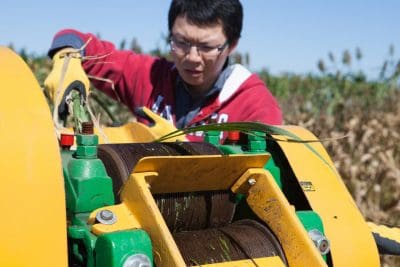TODAY many biofuel refineries in the United States operate for only seven months each year, turning freshly harvested crops into ethanol and biodiesel.
When supplies run out, biorefineries shut down for the other five months.

Haibo Huang, an assistant professor at the Virginia Polytechnic Institute and State University, squeezes bio-oil out of petross sugarcane to process into biodiesel. Photo: Haley Ahlers/Petross
However, according to recent research, dual-purpose biofuel crops could produce both ethanol and biodiesel for nine months of the year – increasing profits by as much as 30 per cent.
“Currently, sugarcane and sweet sorghum produce sugar that may be converted to ethanol,” said co-lead author, Stephen Long, Gutgsell Endowed Professor of Plant Biology and Crop Sciences at the Carl R. Woese Institute for Genomic Biology at the University of Illinois in the United States.
“Our goal is to alter the plants’ metabolism so that it converts this sugar in the stem to oil – raising the levels in current cultivars from 0.05pc oil, not enough to convert to biodiesel, to the theoretical maximum of 20pc oil. With 20pc oil, the plant’s sugar stores used for ethanol production would be replaced with more valuable and energy dense oil used to produce biodiesel or jet fuel.”
A paper published in Industrial Biotechnology simulated the profitability of Plants Engineered to Replace Oil in Sugarcane and Sweet Sorghum (PETROSS) with 0pc, 5pc, 10pc, and 20pc oil.
They found that growing sorghum in addition to sugarcane could keep biorefineries running for an additional two months, increasing production and revenue by 20-30pc.
Today, PETROSS sugarcane produces 13pc oil by dry weight, 8pc of which is the kind of oil used to make biodiesel.
At 20pc oil, sugarcane would produce 13 times more oil–and six times more profit–per acre than soybeans.
A biorefinery plant processing PETROSS sugarcane with 20pc oil would have a 24pc international rate of return–a metric used to measure the profitability of potential investments–which increases to 29pc when PETROSS sorghum with 20pc oil is processed for an additional two months during the sugarcane offseason.
“When a sugarcane plant has to shut down, the company is still paying for capital utilization; they have spent millions of dollars on equipment that isn’t used for five months,” said co-lead author Vijay Singh, Director of the Integrated Bioprocessing Research Laboratory at Illinois.
“We propose bringing in another crop, sweet sorghum, to put that equipment to use and decrease capital utilization costs.”
By decreasing capital utilization costs, the cost to produce ethanol and biodiesel drops by several cents per litre.
Processing lipid-sorghum during the lipid-cane off-season increased annual biofuel production by 20 to 30pc, thereby increasing total revenue without any additional investment in equipment.
The simulations in this paper accounted for the equipment required to retrofit ethanol plants to produce biodiesel.
In the US, about 90pc of ethanol plants are already retrofitted to produce biodiesel.
According to Singh, in places like Brazil where they produce a large amount of sugarcane, it makes sense to retrofit ethanol plants.
“Our study shows that it is cost effective to do it.”
Source: University of Illinois

HAVE YOUR SAY